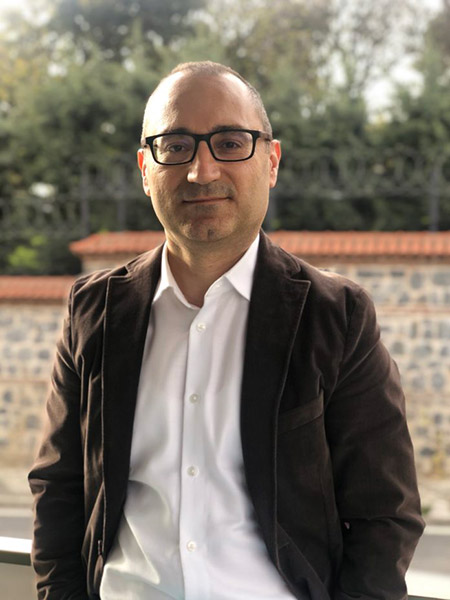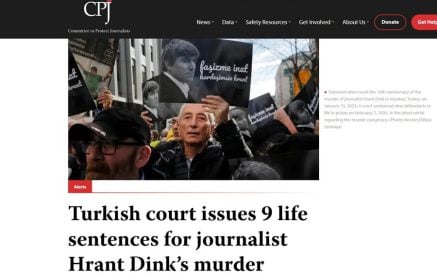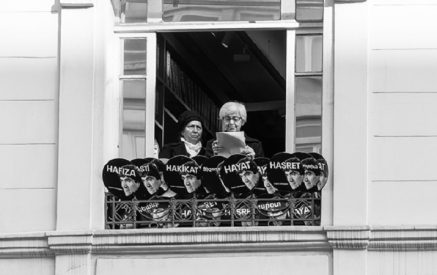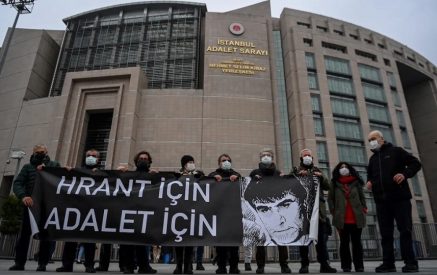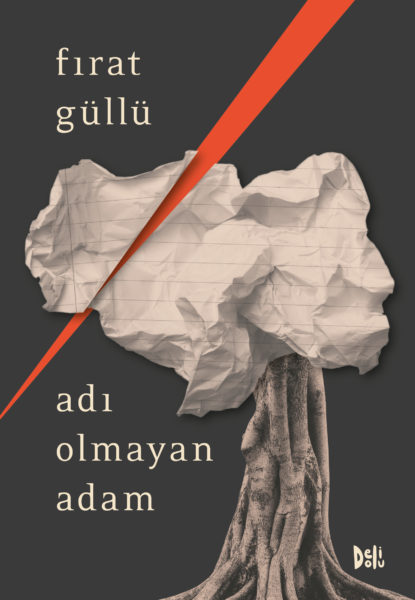by Artsvi Bakhchinyan
YEREVAN / ISTANBUL — Fırat Güllü is a Turkish historian, writer, translator and theater historian. He has a Bachelor’s degree in History and a Master’s degree from the Atatürk Institute for Modern Turkish History at Boğaziçi University. He has carried out acting, instructing, and directing responsibilities within Boğaziçi University Players for years, as well as acted in various productions at Theater Bosphorus. His various translations and writings were published in “Mimesis – The Translation and Research Periodical of Theater.” Fırat is a member of the Bosphorus Performing Arts Ensemble and of the Editorial Board of “Mimesis.” He published his works on Ottoman performing art history named “Vartovyan Theatre Company and the Young Ottomans” in 2008 and “System Crisis and Theater in the Ottoman Empire” in 2017. Fırat Güllü translated Kevork Bardakjian’s PhD thesis named “Hagop Baronian’s Political and Social Satire” into Turkish together with Zeynep Okan (from English into Turkish). Finally, this year, he published a novel called “The Man Without a Name,” inspired by the life of Istanbul-based Armenian playwright Arman Vartanyan (1930-2015). Fırat is a member of the History Foundation and of the Editorial Board of its periodical “Toplumsal Tarih” (Social History) and works as a history teacher in a private high school.
Read also
Fırat, we met in 2013 in Venice, where you were part of Summer Course of Armenian Language and Culture. Where are your Armenian interests come from?
Sometimes they ask if I am the grandson of the famous Armenian theater director Güllü Agop (Hagop Vartovyan) because of my surname, but it couldn’t be possible for me to truly discover this important figure of our cultural history till I started working on theater history. I knew very little about the great contribution made by famous Armenian actors and actresses to the modernization of Turkish theatre. In fact, I did not have the opportunity to focus on the subject until 2007. Hrant Dink’s assassination in that cursed year pushed every conscientious citizen of the Republic to a serious confrontation with the official nationalist history. This sad historical turning point caused me to completely change my works’ direction and I started to work on Armenian theater in the Ottoman and Republican eras.
Turkish theater specialist Metin And wrote that how much we thank the Armenians for their contribution to Turkish theater, will not be enough. Yet about this contribution only narrow circle of specialists know.
Especially in his first works in the 1960s and 1970s, Metin And tended to consider the development of modern theater in Turkey from a multicultural point of view. It was a pioneering effort in the academy, which usually had a rather nationalistic structure. However, after the military coup of September 12, 1980, because of the witch-hunt against left-leaning intellectuals, his approach to his earlier works began to change. The epilogue to the new edition of his important monography about Hagop Vartovyan named “The Ottoman Theater” (firstly published in 1960s and then in 1990) is a clear indication of his changing attitude to the issue. I took this topic into consideration in my work titled “Vartovyan Theater Company and Young Ottomans.”
Among your translated books there is also Hagop Baronian’s Political and Social Satire by American-Armenian researcher Kevork B. Bardakjian. Was it your own initiative or there was certain interest from Turkish circles in this 19th century Armenian writer, a pioneer of satiric writing in the Ottoman Empire?
Baronian was already known to a narrow circle because of his satirical newspaper Tiyatro published in Turkish in the 1870s. However, as a playwright, he was not widely known outside the Armenian community. In his work on Vartovyan, Metin And was the first to introduce him to the non-Armenian-speaking Turkish community as a playwright and theater critic from 19th century Istanbul. In 2010, as the Boğaziçi Performing Arts Ensemble in collaboration with Aras Publishing, we organized a “Baronian Day” at Boğaziçi University and invited Kevork Bardakjian to give a lecture — this was the first public conference as far as I know in Armenian language in this university. Within the scope of this event, his play “Oriental Dentist” was translated into Turkish by Boğos Çalgıcıoğlu, published by Aras Publishing, and later turned into a popular stage event by the Istanbul Metropolitan Municipality City Theatre. The book you mentioned was the last link of these studies on Baronian.
Armenian figures are your subjects of interest also in your fiction. The first one is your play on friendship of two eminent figures of Armenian and Turkish theaters — Vahram Papazyan and Muhsin Ertuğrul.
In the conversation we had during a lunch in Venice, I told you how the life of my grandfather, who worked as a decorator at the State Opera and Ballet in Istanbul, changed thanks to Muhsin Ertuğrul. After that you told me that your grandmother, who was responsible for costumes at the Armenian Theater in Tbilisi, worked with Vahram Papazyan. As you will remember, later the complex relationship of these two men became a source of inspiration for a short play called “Muhsin and Vahram,” which we staged in partnership with the Berberian Theatre Company. It was staged at an event at the International Istanbul Theater Festival in 2014, in which you also participated as a panelist. However, the story did not finish at that point, and that short play, by the efforts of Cüneyt Yalaz, İlker Yasin Keskin and Banu Açıkdeniz from the Boğaziçi Performing Arts Ensemble, turned into an award-winning professional project named “Kim Var Orada?” (Who’s There?).
And you created another Armenian protagonist in your recently published novel, The Man without a Name. It awarded second prize in the Tudem Literature Award Novel Competition. Your novel is based on the life of the Armenian playwright from Istanbul, Arman Vartanyan. I remember Mr. Arman, an interesting person indeed.
The story of the novel began in May 2018 at a seminar with dear friend Sevan Değirmenciyan at Boğaziçi University. When we started working on Vartanyan, we were surprised to see that his works was not well known in theater circles, even in the community he belonged to. If we didn’t have the biography that written by his second wife Zarine Vartanyan Grigoryan, who is a citizen of Armenia, we would be faced with a mysterious writer who left almost nothing about his life story. Sometimes the historian uses his imagination when facts are inaccessible and unknowable. I think I couldn’t regulate the dose of imagination and the text I wrote turned more of a fiction than a true biography.
Arman Vartanyan left a legacy of strange plays with unusual titles. Have you read them, and have you ever tried to use his style in your novel?
During our research, we saw that Vartanyan was one of those secretive writers who used a language difficult to understand. He didn’t like to talk much about his works. It is not easy for the readers or the practitioners who want to stage his plays to understand his texts without doing some research and making some extra effort to explain them. Although his plays “Tokhor” (The Least Weasel), “Gangruk” (The Blister) and “Akhasel” (The Ritual Doll) were successfully translated into Turkish, they failed to attract the attention of non-Armenian-speaking Turkish readers. It was a very enriching experience for me to deal with these elusive texts while preparing for the seminar. While writing the novel, I tried to include the powerful metaphors that these texts created in my imagination. I hope I was successful.
I hope your novel will be translated into Armenian and we will be able to read it. Your books on Armenian topics surely are interesting to Armenian readers, but do they have also Turkish audience?
My previous research books of a non-fiction nature have attracted attention within a narrower academic group. The novel was published in April. Unfortunately, during the year publishing houses couldn’t be able to meet with readers in book fairs due to the conditions created by the pandemic. Despite this, the information I received from my publisher is that the readers’ interest is quite good. From the conversations I had and the various messages I received I got the impression that the readers approached my novel with sympathy. I can say that it has gained an appreciation especially in the Armenian community of Istanbul. Honestly, that makes me very happy.
Is there a special reason to dedicate your novel to our mutual friend (alas, now diseased) Yervant Baret Manok?
Baret was a person who believed that regardless of the foreign policies of the states, people could improve their relations through dialogue peacefully. His optimistic vision has always inspired me. As you know, unfortunately, we lost him at a very early age, and there’s still a lot of things he can do. He knew that I was writing this novel, and especially in the scenes took place in Venice, the effects of our trips along the streets of this city with him in the summer of 2013 are felt, but unfortunately he did not have the opportunity to see the novel completed.
You visited Armenia twice some years ago. You are among Turkish intellectuals who try to build a dialogue with Armenians through culture and common past. But now after last year war between Armenia and Azerbaijan, in which Turkey played the main role, it seems extremely difficult to figure this dialogue. What do you say, how can we proceed?
As you know, the relations between our countries were considered as a taboo in the first period when Armenia gained independence. At the beginning of the 2000s, we lived a relatively democratic period inside the country which led Turkey’s relations changing positively with its neighbors with the start of the European Union admission processes. The conference titled “Ottoman Armenians in the Last Period of the Empire” held at Bilgi University in 2005 became an important turning point. The assassination of Hrant Dink caused a serious social reaction among a wide group in society. Turkish intellectuals who were interested in Armenian culture discovered Yerevan, and a visible activity began to be experienced in non-official cultural and intellectual relations with Armenia. The efforts of the Hrant Dink Foundation to develop humanitarian relations between the two countries have received a positive response. However, the last Armenian-Azerbaijani war has also shown that there is still a long way to go in this regard, and any effort to be made has great value.




















































